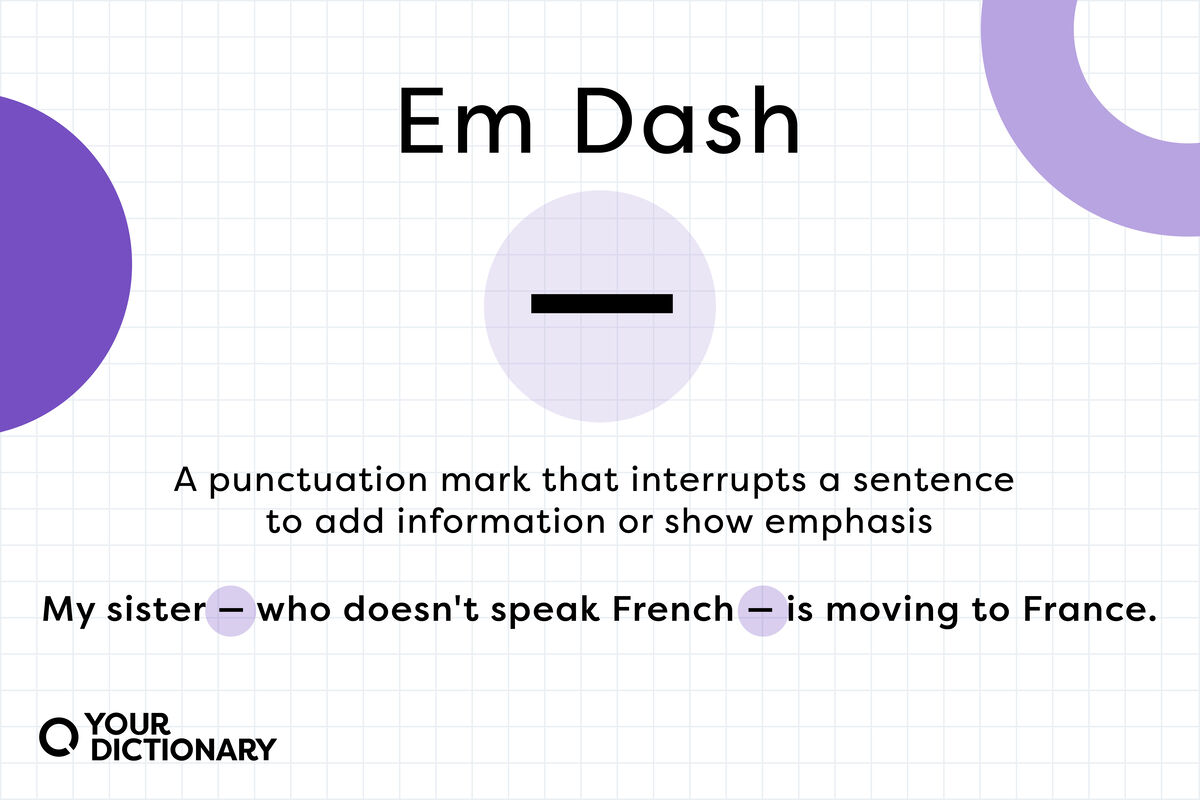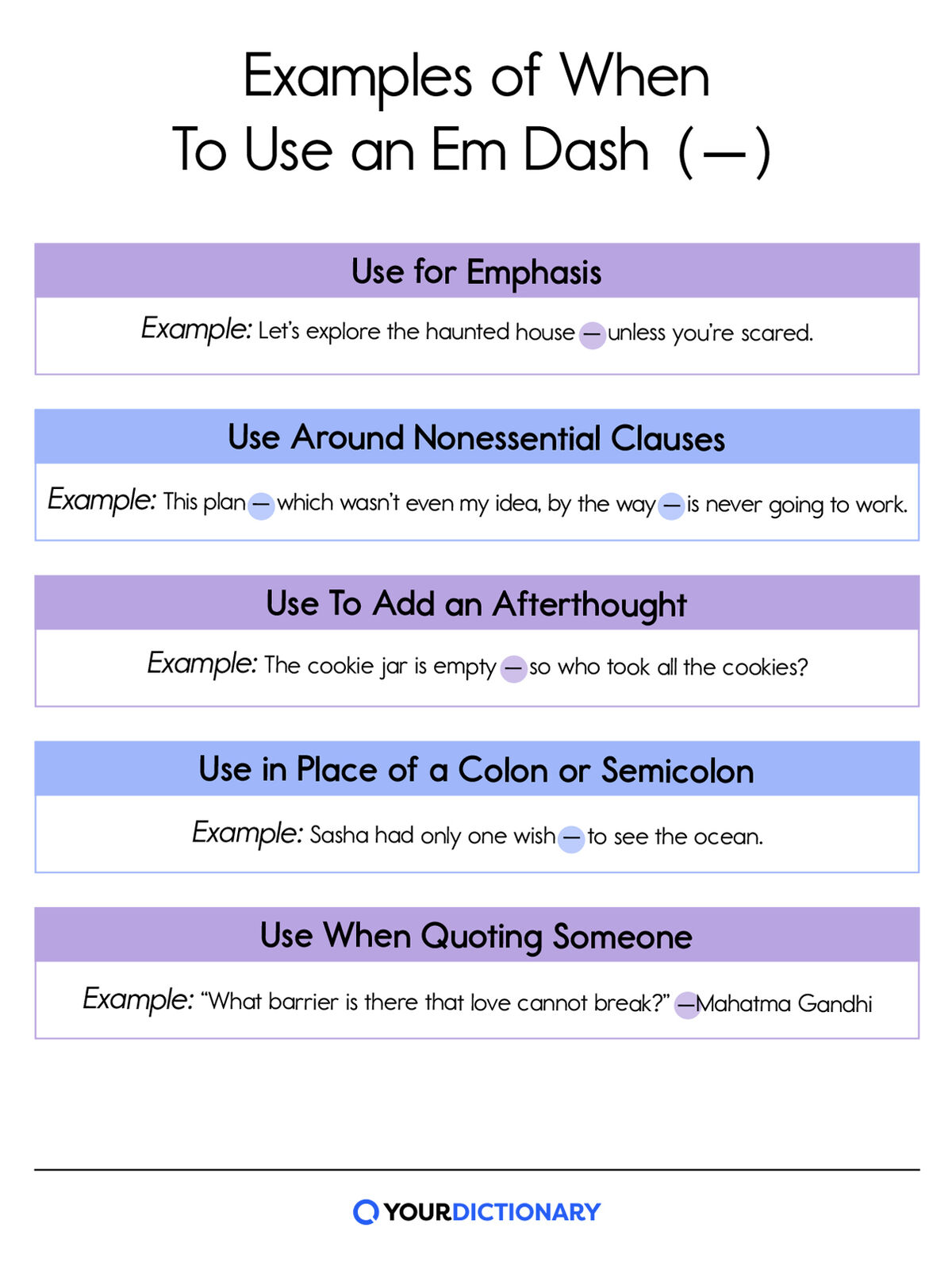
The em dash (—) is a punctuation mark used to interrupt a sentence to add information or show emphasis. It’s called an em dash because it’s as wide as the letter “M.”
If you use it correctly, the em dash can be your friend, instead of just an annoying interruption.
Examples of Em Dashes in a Sentence
Em dashes are a stylistic way to change your sentence variety, which makes your writing more interesting to read.
They’re especially common in informal writing and published fiction.
- You can join our club — unless there’s something you’re not telling us.
- My sister — who doesn’t know a word of French — wants to move to France.
- It doesn’t matter if you win or lose this game — I’ll always be proud of you.
- The main ingredients of a cake — particularly milk, flour, and butter — are available at any grocery store.
How To Use an Em Dash
There are different ways to create an em dash on various devices and word processors.
- Mac: Option + Shift + Hyphen key
- Windows: Alt + 0151 (number pad)
- Microsoft Word: Ctrl + Alt + Minus key (number pad)
- Google Docs: Type three hyphens in a row (it will become an em dash)
You can also use auto-format in Microsoft Word to create an em dash. Write a word, then a hyphen (no space), then another word. Hit space — your hyphen should now be an em dash.
Put spaces before and after the em dash if you are using AP style, which is what most newspapers and magazines use.
- “Police Investigate Unlikely Robbery Suspect — the School Librarian”
Don’t put spaces before and after the em dash if you are using MLA format, Chicago Manual of Style, or APA stylebook.
- “Librarian Confesses to Theft—Claims ‘I Just Needed More Books’”
Fast Fact
The em dash is longer than the en dash (which is as wide as the letter “N”) and even longer than the hyphen.

When To Use an Em Dash
Em dashes create breaks in a sentence. They are used to:
- connect two sentences together (or replace a comma) to add emphasis
- to replace a colon or semicolon to add emphasis
- to separate nonessential information from the rest of a sentence
- to show the reader that part of a sentence is an afterthought
- to add a person's name to a quote

Use an Em Dash for Emphasis
Remember your friend from the party? This usage of the em dash is also grabbing your elbow for attention.
Em dashes can replace periods or commas between clauses to add a bit of emphasis.
- I don’t know that man. I’ve never even seen him before.
- I don’t know that man — I’ve never even seen him before. (More dramatic)
- Let’s explore the haunted house, unless you’re scared.
- Let’s explore the haunted house — unless you’re scared. (More dramatic)
Use Em Dashes Around Nonessential Clauses
Nonessential clauses are groups of words that add extra information to a sentence, but aren’t necessary for understanding that sentence.
You can use parentheses or commas to separate nonessential clauses or lists when you want the information to be more of an aside to the reader.
However, if you want the information to stand out more, use one em dash before the clause and another one after the clause.
- This plan, which wasn’t my idea, is never going to work.
- This plan — which wasn’t even my idea, by the way — is never going to work.
- We’ll read three plays (Hamlet, A Doll’s House, and A Raisin in the Sun) before comparing them in class.
- We’ll read three plays — Hamlet, A Doll’s House, and A Raisin in the Sun — before comparing them in class.
Use an Em Dash To Add an Afterthought
Sometimes nonessential clauses come at the end of a sentence. They’re known as afterthoughts, and they can clarify another part of the sentence, answer a future question, or even ask a related question.
When adding an afterthought to a sentence, you don’t need a second em dash, since the end punctuation will end the sentence by itself.
- John really wants to see his family — especially his mom.
- I’m single right now — and no, I don’t want to go on a blind date.
- The cookie jar is empty — so who took all the cookies?
Use an Em Dash in Place of a Colon or Semicolon
Like an em dash, a colon can “point” to a word or phrase in a sentence.
If the two parts of the sentence aren’t closely related, you can use an em dash instead to add more emphasis.
- There’s one thing I won’t tolerate: disrespect.
- There’s one thing I won’t tolerate — disrespect.
- Sasha had only one wish: to see the ocean.
- Sasha had only one wish — to see the ocean.
Semicolons function by joining two independent clauses together. If you’d like to use an em dash instead (or you want to give more emphasis to the second clause), you can.
- Cats are clean and independent; plus, they don’t bark at the door.
- Cats are clean and independent — plus, they don’t bark at the door.
- You’re thirty minutes late; the meeting started without you.
- You’re thirty minutes late — the meeting started without you.
Use an Em Dash When Quoting Someone
Another way to use em dashes is after quoted text, just before the quote attribution (the person who said it).
“What barrier is there that love cannot break?” —Mahatma Gandhi
When Not To Use an Em Dash
Just like your party-interrupting friend, em dashes sometimes need boundaries.
There are still a few times when you’re better off not using them, or using another punctuation mark instead.
Don’t use an em dash:
- in formal writing (stick to semicolons and commas instead)
- to link compound words (use a hyphen instead)
- to show ranges of numbers or dates (use an en dash instead)
- to replace prepositions to, through, from, or between (use an en dash instead)
- more than once per paragraph (it’s repetitive)
- in a sentence or paragraph that already has a semicolon (also repetitive)
Quiz Time: Practice Adding an Em Dash
A Dash of Punctuation
The key to using em dashes is right there in the name. You only need a dash of them in your writing; otherwise, like that party friend, they’re going to get on people’s nerves.
Think of them like exclamation points — they’re most effective when used sparingly.